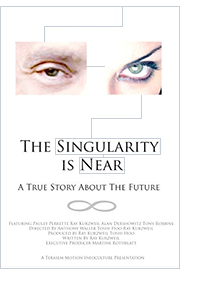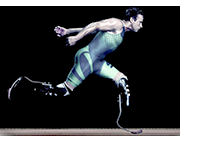H+ Summit @ Harvard
 Sunday, June 13, 2010 at 11:56PM
Sunday, June 13, 2010 at 11:56PM Due to a schedule conflict I was unable to attend the Humanity+ Summit in person. Thankfully it was live streamed. I’ve included Ray Kurzweil’s Keynote here:
Ray, often in the spotlight these days, was even more visible than usual this weekend, with a multi-page story in the New York Times on Friday, as well as a brief bio at #62 in Fast Company’s list of the 100 Most Creative People in Business.
While Ray (and fellow Keynote Speakers, Stephen Wolfram & Aubrey de Grey) may have drawn the crowds, it was a talk by Robert Tercek — President, Digital Media, OWN: The Oprah Winfrey Network — that struck a nerve with me and, I think, many others as well. So I’ve included video of his talk below, as well as the slides from his presentation. While most of the speakers were intelligent and insightful, it was also well trodden ground for those active in this community. Ray is a great lecturer however, in this venue, he was inevitably preaching to the choir (with all the religious baggage that statement carries).
My thoughts: To get traction, respect and most importantly goodwill beyond the inner-circle, the transhumanist/singulatarian community needs not only to put thought into these things, but action behind them. Renaming the organization Humanity+ (previously The World Transhumanist Association) was a big step in the right direction. But this is only superficial if it is not backed up with action. I have had some recent dialog with our Executive Director, Alex Lightman, regarding this matter. There is some intellectual discomfort by some in the movement with the fact that much of the research done in Transhumanist studies (nano-bio-info-cog) has been financed by the U.S. military. Patrick Lin’s lecture at the summit addressed some of these issues. But not all of this research has been focused on waging war. In recent years, a great deal of research financed by the U.S. Military has funded next-generation robotic prosthetics, artificial eyes, and other medical applications related to body/machine and brain/machine interfaces. This is due to the large number of disabled veterans returning from the wars in Iraq and Afghanistan — While battlefield casualties have dropped astoundingly since the days of World War II and even Vietnam, this is largely due to medical advances that have allowed more soldiers to survive wounds that in prior conflicts would have been fatal. The number of returning disabled veterans has risen at a rate near proportional to that which war related deaths have declined. This has left us with a very large number of disabled veterans from the past decade’s military conflicts. Consequently, the military has been investing heavily in human/machine interface technologies to improve the mobility and overall quality of life of these veterans. I have been espousing the position that Humanity+ should be looking for opportunities to get involved in veterans affairs. Whatever one’s position on any given conflict may be, we are the benefactors of this research, and these veterans have paid a very heavy price in order to be the guinea pigs for this research. Today’s American veterans are indeed humanity’s first true cyborgs. What form this involvement should take has not yet taken shape, but I have been in some informal dialog with Doug Thompson of Remedy Communications, to see if there isn’t a place for Humanity+ to either be involved in their efforts, or at least to advise us on where our community’s strengths could best be leveraged in assisting veterans. If Humanity+ is to be an organization that lives up to its name, this would be a very noble start.
There were many other excellent speakers including Nolan Bushnell, founder of Atari; Andrew Hessel, Co-Chair of Singularity University; and noted futurists like Natasha Vita-More, Ben Goertzel and John Smart… and one of my personal favorites, Patrick Hopkins, the spoiler, on why mind “uploading” will not work as life extension.
 An announcement worth noting: during Hank Hyena’s excellent talk, Alex interjected to inform everyone that H+ Magazine, which had previously been sold to Better Humans and was recently put back up for sale, has now been reacquired by Humanity+ where it will be put immediately back into publication. Many readers may have never known it was shut down, save for a recent letter posted to the editor’s blog. The website was kept live, but as a contributing writer (1|2), R.U. has kept myself and other contributors in the loop on things going on behind the scenes to try and secure a new buyer. I am very pleased to know that H+ Magazine has survived the ordeal.
An announcement worth noting: during Hank Hyena’s excellent talk, Alex interjected to inform everyone that H+ Magazine, which had previously been sold to Better Humans and was recently put back up for sale, has now been reacquired by Humanity+ where it will be put immediately back into publication. Many readers may have never known it was shut down, save for a recent letter posted to the editor’s blog. The website was kept live, but as a contributing writer (1|2), R.U. has kept myself and other contributors in the loop on things going on behind the scenes to try and secure a new buyer. I am very pleased to know that H+ Magazine has survived the ordeal.
Thanks to David Orban, Chairman; and Alex Lightman, Executive Director of Humanity+ for making this event happen. Also a special thanks to Kevin Jain whom I am told was instrumental at securing Harvard as the venue for the event.
 Ray Kurzweil, June 24, NYC
Ray Kurzweil, June 24, NYC
Ray Kurzweil will be speaking in New York City on June 24th, at the New York film premier of his movie, The Singularity is Near, based on his best selling book of the same name — The Singularity Is Near: When Humans Transcend Biology.
Presented by the WTN Imagined Worlds Film Series, in association with TIME Magazine. Advanced ticket sales are available online for $35, or $55 at the door. Time & Life Building, 1271 Avenue of the Americas (6th Avenue) between West 50th & West 51st Streets. See Map.
Disclosure: I am both a dues-paying member of Humanity+
and a contributing writer to h+ Magazine.
 In the 1980s, Bruce, along with William Gibson and Rudy Rucker, was one of the writers who created the Cyberpunk Science Fiction sub-genre. Though his stock has always remained high, his mainstream profile has been rising, as a futurist cultural commentator. As a contributing editor to
In the 1980s, Bruce, along with William Gibson and Rudy Rucker, was one of the writers who created the Cyberpunk Science Fiction sub-genre. Though his stock has always remained high, his mainstream profile has been rising, as a futurist cultural commentator. As a contributing editor to  Legendary game developer, in 1989 Will created
Legendary game developer, in 1989 Will created  Blaise founded software company
Blaise founded software company  Youthful diversions as a stand-up comic, and juggling circus clown groomed Jesse for his role as Creative Director for the Walt Disney Imagineering Virtual Reality Studio — seven years creating immersive visitor experiences for Walt Disney theme parks. In 2004 he left to start his own entertainment design firm,
Youthful diversions as a stand-up comic, and juggling circus clown groomed Jesse for his role as Creative Director for the Walt Disney Imagineering Virtual Reality Studio — seven years creating immersive visitor experiences for Walt Disney theme parks. In 2004 he left to start his own entertainment design firm,  4. Before the year is out, a translucent AR tablet device will be available on the consumer market. The concept as shown at left is of the
4. Before the year is out, a translucent AR tablet device will be available on the consumer market. The concept as shown at left is of the  1. An
1. An 




 But it is worth pointing out that John Podesta was previously a member of Bill Clinton’s administration. Clinton’s
But it is worth pointing out that John Podesta was previously a member of Bill Clinton’s administration. Clinton’s 

